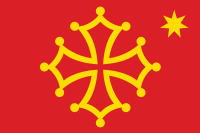- Occitan cross
-
The Occitan cross — also cross of Occitania, cross of Languedoc, cross of Forcalquier and Toulouse cross — is the symbol of Occitania. It was first used as such, probably, in the coat of arms of the counts of Forcalquier in Provence, and then by the counts of Toulouse in the traditional territory of Languedoc and later spread to the other provinces of lo país, namely Provence, Guyenne, Gascony, Dauphiné, Auvergne and Limousin.
A yellow Occitan cross on a blood-red background with the seven-armed golden star of the Felibritge makes up the flag of modern-day Occitania. It can also be found in the emblems of Midi-Pyrénées, Languedoc-Roussillon and Hautes-Alpes, among many others, as well as in cemeteries and at country crossroads.
The Occitan cross is technically described as "mouthed and hollowed out, with keys (or paws) and golden spheres" (de golas a la crotz voidada, clechada (or patèa) e pometada d'aur). In La Cançon de la crosada, it goes by the name of Raymondine cross (crotz ramondenca, laisse 109). It's still the object of a dispute among experts as to whether its first appearance in Occitania was in Provence or Languedoc.
Contents
History
The Occitan cross probably first appears in the coat of arms of the counts of Forcalquier and then during the reign of Raymond V, count of Toulouse, as a particular description of his official seal dated from 1165[1] corroborates. It soon spreads across the whole south-western part of today's France and is even spotted in various towns up north throughout the XIIth Century. Several interpretations have been proposed for the cross, often stressing the symbolic side of it and leaving aside the fact that "heraldry is not a science of symbols, but one of emblems" (M. Pastoureau).
In 1950, Henri Rolland[2] suggests that the origin of the Occitan cross be traced back to the marquisate of Provence, north of the Durance, more precisely the town of Venasque.[3]
In 1966, in the L'Auta review, Roger Camboulives voices his idea that the Occitan cross derives from a sun cross and perhaps the Nestorian cross found in China's Turkestan. It would have arrived in Toulouse via northern Italy and Provence, probably sometime in the Xth Century. In 1980, Camboulives again emphasizes the role played by the Wisigoths in the presence of small spheres at the end of the arms of the cross: they could represent the twelve houses of the zodiac.[4] This hypothesis would definitely locate the birth of the Occitan cross in or around Toulouse.
A demonstration for Occitania and the Occitan language in Béziers on March 17, 2007
In 1986, Jean-Yves Royer (in Le Pays de Forcalquier) claims that the cross was originally from Provence but admits that Henri Rolland's theory was flawed and built around wrong dates. Royer concludes that Rolland possibly mistook the Occitan cross with that of Forcalquier.[5] He draws evidence most notably from two crosses carved in the lid of a sarcophagus found in the small Alpes-de-Haute-Provence commune of Ganagobie.
In the December, 1994 edition of the Archistra magazine, Pierre Saliès once again maintains that the cross is from Toulouse and is the fruit of successive local evolutions, possibly from the Jerusalem cross.[6]
Two years after, in L'Auta (#612), Jean Rocacher confirms that the Occitan cross "is first the own emblem of the old county of Venasque, later torn between the houses of Toulouse and Forcalquier."
In 2000, Laurent Macé (in Les Comtes de Toulouse et leur entourage) claims that the Occitan cross became the counts' emblem after Raymond IV took part in the First Crusade. It would originate from Constantinople.[7] Macé indicates that its pattern was first found in the Byzantine area and spread across Western Europe through Italy and Provence. The crosses of Venasque and Forcalquier would thus share the same origin, though one was not inspired by the other.
Later in the same year, Bertran de la Farge (in La Croix occitane) locates the original Occitan cross somewhere in the marquisate of Provence, probably Venasque. He argues it could be a mixture of the Constantinople cross and the Coptic cross, which was brought to Provence by monks and maybe also through Saint Maurice.
As for now, there is no undeniable evidence as to which side is right.
Modern uses
 The modern Occitan cross on the flag of Occitania
The modern Occitan cross on the flag of Occitania
The Occitan cross can be found on a number of flags, coats of arms, emblems and logos. Here follows a non-exhaustive list of occurrences:
Regions and provinces
- Flag of Languedoc-Roussillon [1]
- Flag of Midi-Pyrénées [8]
- Logo of Midi-Pyrénées
- Flag of the Aran Valley [2]
Départements
- Coat of arms of Aude [9]
- General Council of Aude [3]
- Coat of arms of Gard [10]
- Coat of arms of Hautes-Alpes [4]
- Coat of arms [11] and flag [12] of Haute-Garonne
- Coat of arms of Hérault [13]
- Coat of arms of Tarn [14]
- Coat of arms of Tarn-et-Garonne [15]
Cities and towns
Plaça del Capitòli, Tolosa (Place du Capitole, Toulouse)
- Coat of arms of Ansignan [5]
- Coat of arms of Buoux [6]
- Coat of arms of Céreste [7]
- Coat of arms of Colomiers [8]
- Coat of arms of Fanjeaux [16]
- Coat of arms of Gigondas [9][dead link]
- Coat of arms of Laissac [10]
- Coat of arms of Llupia [17]
- Coat of arms of Méthamis [11]
- Coat of arms of Moissac [18]
- Coat of arms of Monclar [12]
- Coat of arms of Port-la-Nouvelle [19]
- Coat of arms of Saint-Didier [20]
- Coat of arms of Sévérac-le-Château [13]
- Coat of arms of the City of Toulouse
- Coat of arms of Travaillan [14]
- Coat of arms of Venasque [15]
- Flag of Vianne [16]
- Coat of arms of Villeneuve-d'Aveyron [17]
- Coat of arms of Villefranche-de-Lauragais [18]
- Coat of arms of Villefranche-de-Rouergue [19]
Miscellaneous
- Logo of Toulouse FC
- Place du Capitole, Toulouse [20] (43°36′16″N 1°26′36″E / 43.604389°N 1.443361°E)
- Coat of arms of La Tour d'Auvergne [21]
- Street-sign in Toulouse [21]
- Roadsigns in Limousin [22]
- Sign of the Conseil Interprofessionnel des Vins du Languedoc [23]
Also see
Sources
- Les Comtes de Toulouse et leur entourage: Rivalités, alliances et jeux de pouvoir XIIe-XIIIe siècles by Laurent Macé (éd. Privat)
- La Croix occitane by Bertran de la Farge (éd. Loubatières)
- Le Pays de Forcalquier by Jean-Yves Royer (éd. Équinoxe)
`
References
- ^ http://www.nimausensis.com/Nimes/templiers/SceauComteToulouse.gif
- ^ Toulouse (Municipality, Haute-Garonne, France)
- ^ http://site.voila.fr/amisdevenasque/croix1.jpg
- ^ http://kalvinz.free.fr/Occitan/croixoczodiac.jpg
- ^ http://jean.gallian.free.fr/comm2/Croix/Image3.gif
- ^ http://individual.utoronto.ca/hayes/survey2/JerusalemCross.gif
- ^ http://www.metmuseum.org/toah/images/h2/h2_1998.542.jpg
- ^ Media:Flag of Midi-Pyrénées.svg
- ^ Media:Blason11.PNG
- ^ Media:Blason30.PNG
- ^ Media:Blason31.PNG
- ^ Media:HauteGaronneFlag.gif
- ^ Media:Blason dpt fr Herault.png
- ^ Media:Blason81.PNG
- ^ Media:Blason82.PNG
- ^ Media:Blason ville fr Fanjeaux (Aude).svg
- ^ Media:Blason Llupia 1.svg
- ^ Media:Blason Moissac.svg
- ^ Media:Blason Port-la-Nouvelle.svg
- ^ Media:Blason ville fr StDidier (Vaucluse).png
- ^ Media:Occitan and French language signs in Toulouse.jpg
Categories:- Cross symbols
- Occitania
Wikimedia Foundation. 2010.




